This is one of my favourite photographs from Paris. I use it as the wallpaper on my desktop computer, so that every day, when I sit down to work, I feel for a second that I am taking my place at a café table on the rue Payenne. And it brings back the day in 2012 when Norman and I and a friend sat there chatting over coffee, after a visit to the nearby Musée Carnavalet. This little fellow decided to join the conversation, lured by the crumbs from the biscuits that came with the coffee.
Years ago, some people made a precarious living luring little birds out of the air for the amusement of passersby, as shown in this postcard. The birds on his hands are called Robinet and Jeannette, according to the verse on the card.
Since sparrows tend to cluster wherever baguette crumbs can be found, I wonder if there was any more art to it than that. Bird whispering? I consulted our book on the “petits métiers de Paris,”* which quoted from Célébrités de la Rue by Charles Yriarte, published in 1864. Yriarte describes watching the Charmeurs d’oiseaux in the Tuileries, who would lure birds with breadcrumbs, but who also seemed to exert a magnetic pull on the creatures, who perched on their hands and heads without fear. There was even a “Charmeuse,” known as Mademoiselle Henriette. Even when she had exhausted her supply of breadcrumbs, the birds would stay with her, following her when she left the park.
Looking at my favourite photo, it occurred to me that many of my happiest days in Paris seem to have a connection to birds. And Norman has taken some wonderful pictures of them. If you like birds, here are some places to see them.
There was the Christmas Day when we walked across the snowy Jardin du Luxembourg, stopping to watch the ducks in the pond that is part of the Medici fountain.
The Square des Batignolles also has resident ducks and the summer day we went there, we spent some time watching them perform elaborate grooming rituals. It is so important to look one’s best in Paris.
We also noticed a baby, not a duckling, to judge by his enormous (but unwebbed) feet.
We saw a moorhen nearby; could they be related?
On my birthday a few years back, Norman and I took a stroll across the Bois de Boulogne on a glorious June morning, listening to the weird, strangled cries of peacocks, and amused to see how the birds co-existed peaceably with a large population of semi-feral cats.
When we arrived at the restaurant in the Bagatelle gardens, Norman presented me with my birthday present – a silver pendant showing birds on a wire, by the Canadian artist Iris Dorton.
The Bagatelle gardens are also home to some fine swans.
And magpies.
We’ve seen lots of crows. In Norman’s photographs, they sometimes appear as a bird-shaped absence in the middle of the image.
And they look impressive in bare winter trees.
The Quai de la Mégisserie is home to a cluster of pet shops, many of which sell exotic birds. One cold winter day we went into one to warm up and found ourselves surrounded by colourful and rather grumpy characters, far from home and longing for the tropics.
A few ignored us completely.
And then, of course, there are the pigeons. They love Paris. Why wouldn’t they? There are handy little cubbyholes where they can nest.
There are interesting places to perch to get a good view of the passing scene.
There is food to eat and water to drink.
And places to play.
And lots of lovely parks where one can enjoy an undisturbed snooze (this one is in the Parc Monceau).
The municipal authorities are not keen on pigeons, however, and have taken it upon themselves to carry out family planning on behalf of the birds. They have set up large pigeon houses, where they place food and water, and when an egg appears, it is sterilized and prevented from hatching. They call these houses pigeonniers contraceptifs. It’s a relatively humane way of controlling the population, we suppose.
Still, it seems a little ungrateful towards a species that once helped save the city. This was during the siege of 1870-71, when the city was surrounded by Prussian troops, cut off from the rest of the world. The only way for humans to leave was by balloon, and once they left, they could not come back (ballooning was too unpredictable; indeed, one could never know in advance the destination of the outward journey). But pigeons could, and did, return, laden with messages. They travelled out by balloon, were given time to rest before the journey back, then taken as close as safely possible to the city, and released. Most of them found their way back to Paris with their cargo.
And what was that cargo? Microfilm. A photographer, René Dagron, figured out a way to take a picture of hundreds of pages of writing at a time, reduce it to a tiny size, and make copies on rolls of film. These pieces of film were inserted into goose quills attached to the tail feathers of the birds. A single pigeon could carry thousands of letters in this way, and because there were copies, if one bird failed to arrive (the Germans went after them with buckshot and falcons), another would get through. More than 60,000 letters were delivered to Paris addresses during the siege, thanks to the pigeons.**
Of course, pigeons are rather prosaic birds, so in his painting honouring the role of birds in the siege, Puvis de Chavannes used a more attractive dove, cradled by a young woman representing Marianne, the spirit of France, who is fending off a mean-looking German eagle.
Poor pigeons. It seems their past has been stolen from them, and if the anti-fertility campaign succeeds, they have a diminished future. But I doubt if Paris will ever rid itself entirely of these enterprising and often entertaining birds.
Text and images by Philippa Campsie and Norman Ball. Painting by Puvis de Chavannes from Wikimedia.
*Jean-Michel Le Corfec, Les petits métiers de Paris, Editions Sud-Ouest, 2008.
**The full story is told in the wonderful book by Richard Holmes, Falling Upwards: How We Took to the Air, William Collins, 2013.






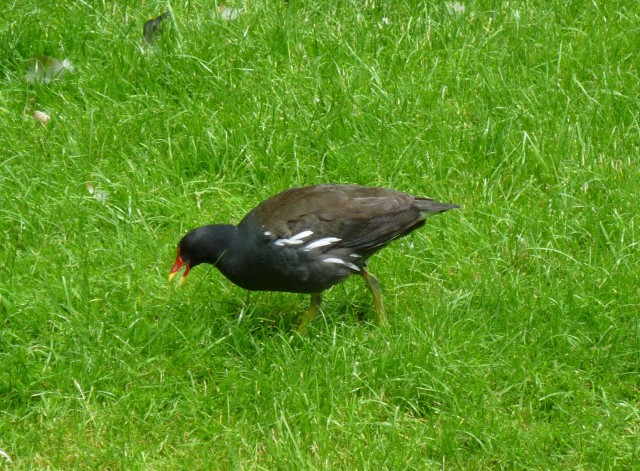












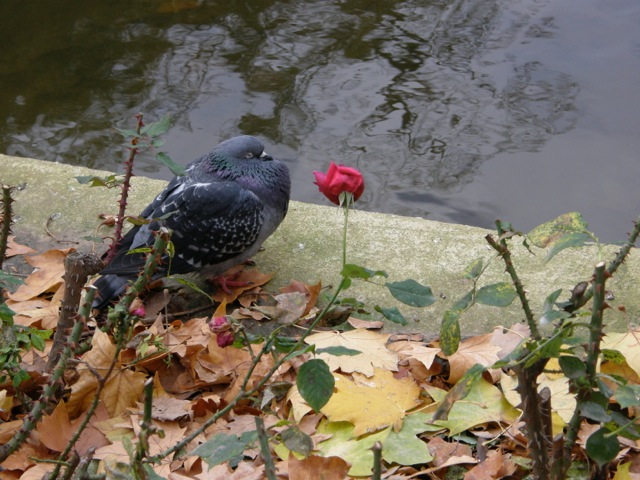









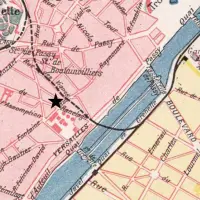

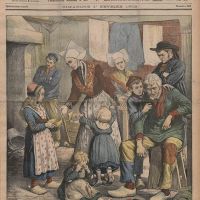

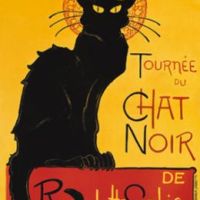









I’m a bird lover too. Thank you for the wonderful pictures and the history lesson too.
Paris without pigeons – incroyable! I throughly enjoyed this column. It brings to mind a photo I took in the Jardin du Luxembourg where there is a statue of a very proud looking lion and what seems unbeknownst to him is a common pigeon perched on his very regal head. There is a metaphor there.
Many thanks,
Wayne Peterson
Pigeons do tend to make some of Paris’s statues of self-important people look less imposing. I think they must be the most democratic of all birds.
Pingback: Parisian Pigeons May Be a Plague to Some but They Once Saved the Capital from Prussians | FrenchNewsOnline
Thank you for the update on these pigeon houses, here it was I thought that they were put up to give the poor birds a chance to have a quiet home for their young to grow up in it is actually a murder station–keeping the parents occupied with laying eggs to no avail. I am disappointed because pigeons to fulfil the job of cleaning up our crumbs!
I always look forward to what you have to tell us, thank you for your wonderful work!!
I imagine the word gets out in the pigeon world: “See those big houses? They look great, but don’t be fooled. You’re better off building a nest on the rooftops.” Pigeons are pretty intelligent!
You can usually count on seeing a heron or two at Bercy Village and in some parks. On the Canal St Martin there are always cormorants striking heraldic poses in winter, and perching in the trees at Lavillette
We shall certainly go looking for the herons and the cormorants! Thank you for the suggestion.
I was a Young Ornithologist, and a fascination with birds has stuck with me. I don’t actively go bird watching in the city today, but there are some nice surprises sometimes – a flock of noisy long-tailed tits on the Passy hill, and peregrine falcons screeching around some of the city’s churches.
Thanks for the book reference – I’m going to buy a copy!
I gather that birds that traditionally nest in cliffs (like falcons) love cities because they have all kinds of breeding places that feel like cliffs. We have them here in Toronto, too.
Another good place to see birds is the Jardin des Plantes, especially the wooded corner called the Labyrinth. On a morning visit I saw lots of birds new to me, so I bought a book to identify them. They included Swifts, Greenfinches, Great Tits, Robins, Song Thrushes, Eurasian Jays, and Common Blackbirds, which have surprisingly pretty songs.
Sorry, that should have been “Dan”, not “Dad”.
What a delightful blog! Thank you. And I’ll be revisiting Paris this Spring with my husband – can someone suggest a compact guide to either the birds of Paris or of Île de France, please? I’ve looked online & found Les Oiseaux d’Île de France, but am not sure if it has photos? I love my Collins for Europe – but want something more specific to the region. Thanks for any help.
Hi Jessica,
There is a “Guide des oiseaux de Paris” published in the 1990s by Parigramme. It seems to be a slim volume of less than 200 pages. Secondhand copies are available.
Here’s the link: http://www.amazon.fr/gp/product/2840960842/ref=olp_product_details?ie=UTF8&me=
It might be what you seek, but I cannot be sure. However, if it is, do please let me know.
Philippa